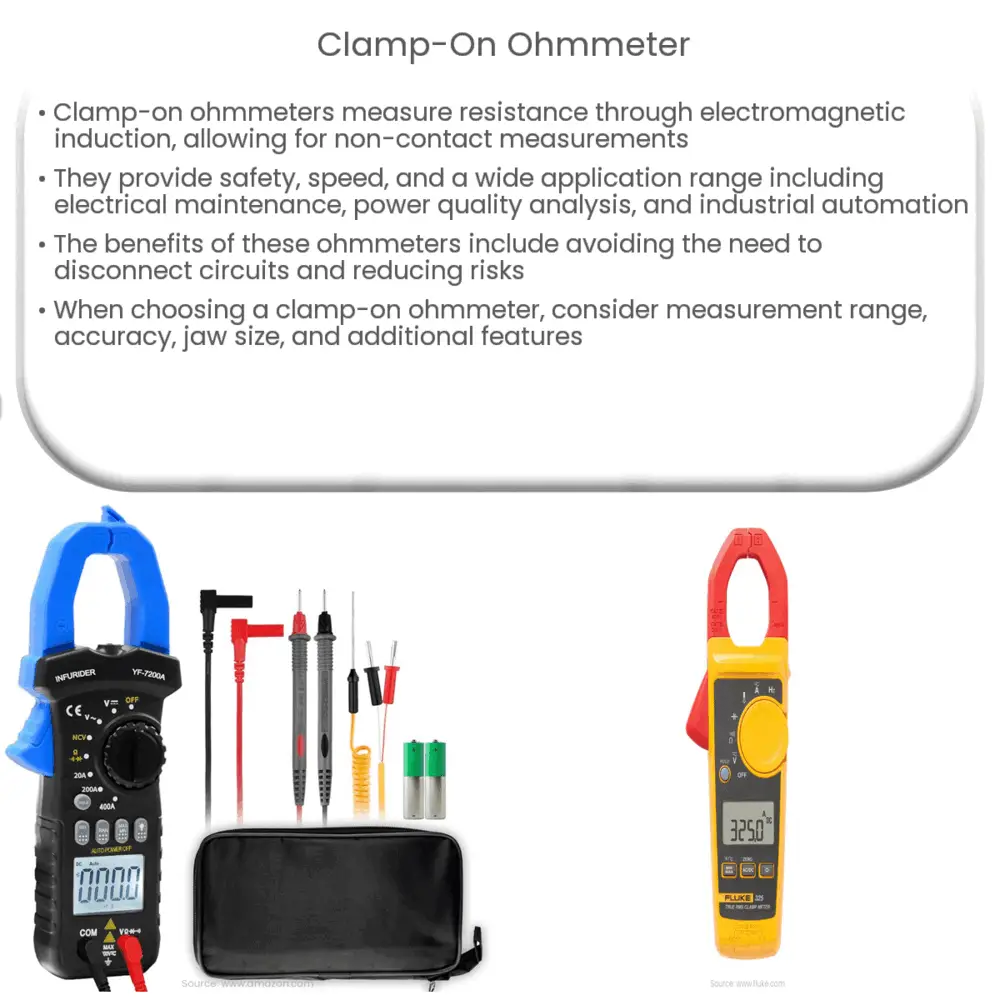Clamp-on ohmmeters measure electrical resistance non-invasively, providing safety, convenience, and accuracy for diverse applications in various industries.

Clamp-on Ohmmeter: An Overview and Its Applications
Introduction
Electrical measurements are a crucial aspect of maintaining and troubleshooting electrical systems. An ohmmeter is an essential instrument used for measuring the resistance of electrical circuits. Among the various types of ohmmeters available, the clamp-on ohmmeter stands out due to its unique design and ease of use. In this article, we will explore the working principle, advantages, and applications of clamp-on ohmmeters.
Working Principle of Clamp-on Ohmmeters
Clamp-on ohmmeters function based on the principle of electromagnetic induction. They consist of a pair of jaws that can be opened and clamped around a conductor without the need to disconnect it from the circuit. The jaws are designed to create a magnetic field when current flows through the conductor. The magnetic field induces an electromotive force (EMF) in the jaws, which is proportional to the current passing through the conductor. This EMF is then measured by the ohmmeter and used to calculate the resistance of the conductor.
Most clamp-on ohmmeters utilize a “current transformer” within the jaws, which is essentially a coil of wire wrapped around a magnetic core. This design allows the ohmmeter to measure the induced EMF with high accuracy and minimal interference from external magnetic fields.
Advantages of Clamp-on Ohmmeters
Clamp-on ohmmeters offer several benefits compared to traditional contact-based ohmmeters. Some of these advantages include:
- Non-invasive measurements: Clamp-on ohmmeters allow for non-contact measurements, which means that there is no need to disconnect the conductor from the circuit. This feature greatly simplifies the measurement process and reduces the risk of damaging the conductor or causing short circuits.
- Safety: Since clamp-on ohmmeters do not require direct contact with the conductor, they provide an added layer of safety for the user. There is no need to handle live wires or expose oneself to the risk of electric shock during measurements.
- Speed and convenience: Clamp-on ohmmeters enable quick and easy measurements, as they can be clamped onto a conductor in a matter of seconds. This feature is particularly useful for troubleshooting and maintenance tasks that require frequent measurements.
- Wide range of applications: Due to their non-invasive nature, clamp-on ohmmeters can be used for various applications, including measuring the resistance of power cables, transformers, motors, and other electrical equipment.
Applications of Clamp-on Ohmmeters
Clamp-on ohmmeters find extensive use in a variety of industries and applications. Some common uses include:
- Electrical maintenance and troubleshooting: Clamp-on ohmmeters are widely used by electricians and maintenance personnel to identify and diagnose issues in electrical systems, such as high resistance connections, faulty components, and cable damage.
- Power quality analysis: Clamp-on ohmmeters can be employed for power quality analysis, allowing users to identify issues like voltage drops and power factor problems in electrical systems. This information is crucial for ensuring the efficient operation of electrical equipment and minimizing energy consumption.
- Preventive maintenance: Regular resistance measurements using clamp-on ohmmeters can help identify potential issues before they escalate into more significant problems. By monitoring the resistance of critical components and connections, users can schedule maintenance activities to prevent unexpected equipment failures and downtime.
- Industrial automation: In automated manufacturing environments, clamp-on ohmmeters can be used to monitor the performance of motors, drives, and other electrical equipment. This information can be utilized for process optimization and predictive maintenance, ultimately improving the overall efficiency of the production line.
Selecting the Right Clamp-on Ohmmeter
When choosing a clamp-on ohmmeter, several factors should be considered to ensure that the selected device meets the requirements of the intended application. Some key considerations include:
- Measurement range: The selected clamp-on ohmmeter should be able to measure resistance values within the range required for the specific application. This may vary depending on the type of equipment and conductors being tested.
- Accuracy: The accuracy of the clamp-on ohmmeter is essential for obtaining reliable measurements. High-quality ohmmeters generally offer better accuracy and are more suitable for critical applications where precise measurements are necessary.
- Jaw size and design: The size of the clamp-on ohmmeter’s jaws should be appropriate for the conductors being measured. Larger jaws may be required for measuring high-current conductors, while smaller jaws are suitable for tight spaces and smaller conductors.
- Additional features: Some clamp-on ohmmeters come with extra features, such as data logging, wireless connectivity, and compatibility with smartphone apps. These features can provide added convenience and functionality, depending on the specific requirements of the user.
Conclusion
Clamp-on ohmmeters are valuable tools for measuring resistance in electrical systems. Their non-invasive, safe, and convenient design makes them ideal for a wide range of applications, from maintenance and troubleshooting to power quality analysis and industrial automation. By carefully selecting the right clamp-on ohmmeter based on the specific requirements of the application, users can ensure reliable and accurate measurements, ultimately improving the performance and efficiency of electrical systems.

